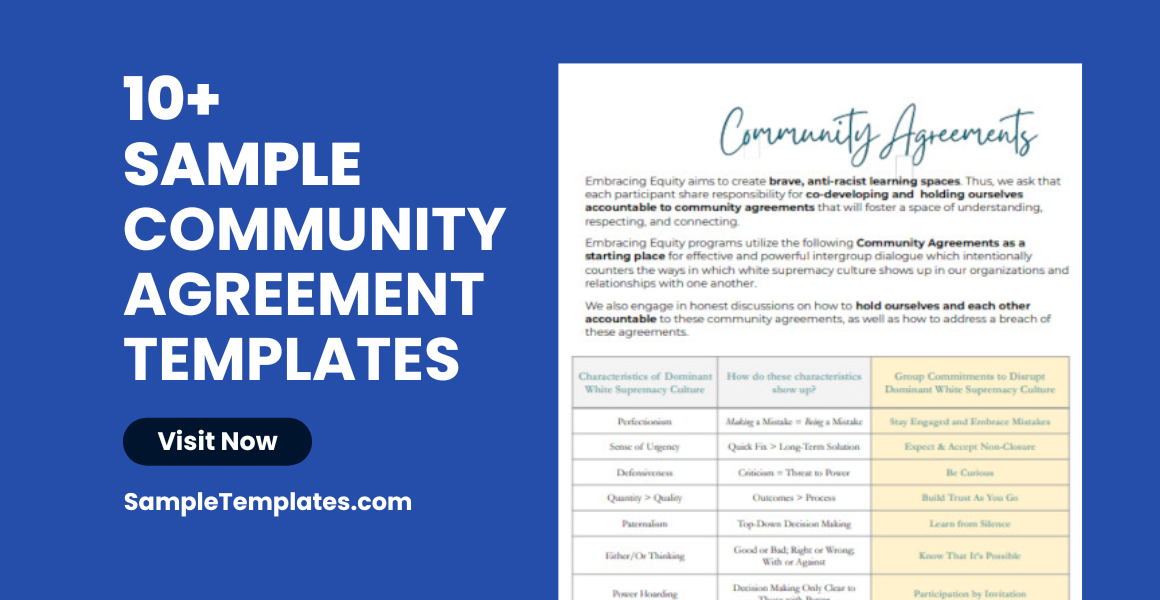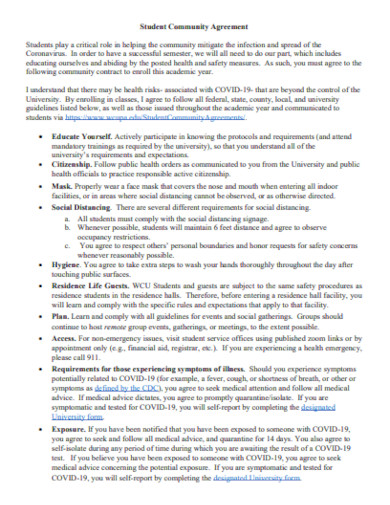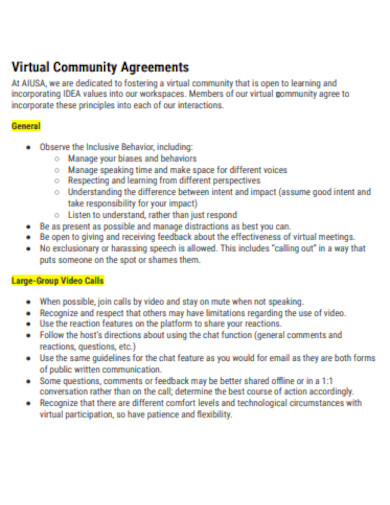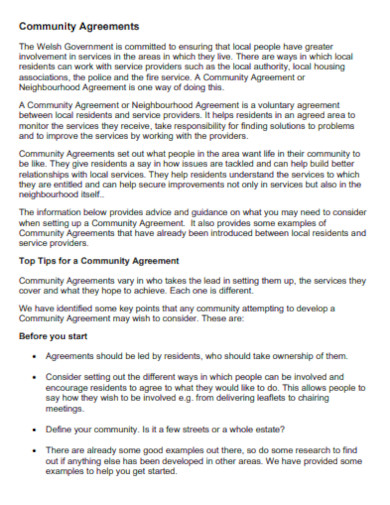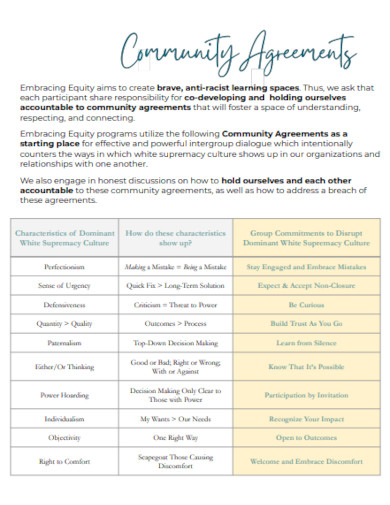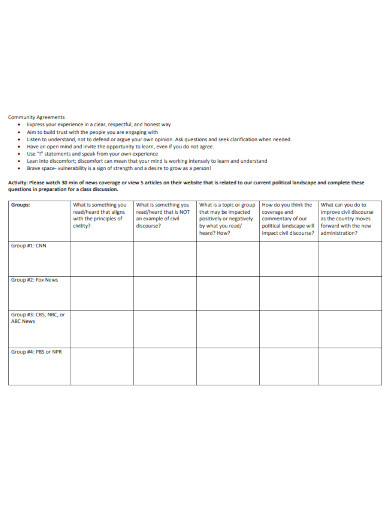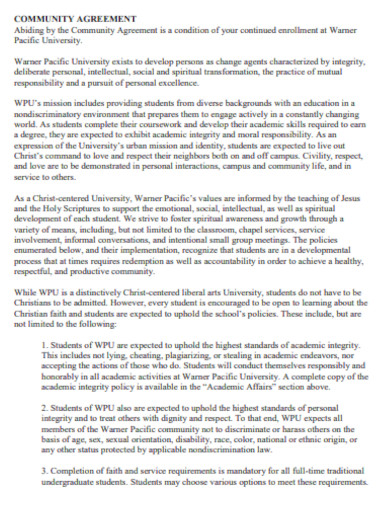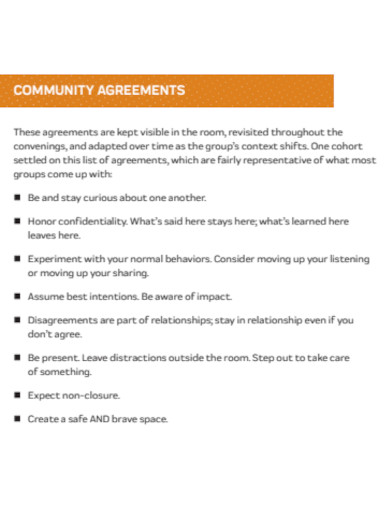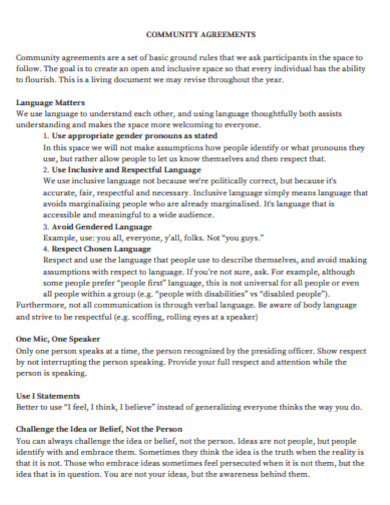10+ Community Agreement Samples
1. Sample Diversity Community Partnership Agreement
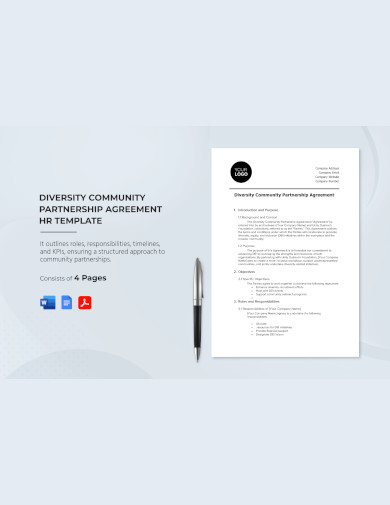
2. Sample Student Community Agreement Template
3. Sample Virtual Community Agreement Template
4. Sample Community Agreement Template
5. Sample Community Meeting Agreement Template
What is a Community Agreement?
Understanding Community Agreements
A community agreement is a shared set of guidelines that members of a community or organization agree to follow to ensure a safe, respectful, and inclusive environment. These sample agreements are often created collaboratively by the members of the community themselves and can be found in various settings, including online forums, educational institutions, workplaces, and social groups.
The Purpose of Community Agreements
The primary goal of a community agreement is to establish a common understanding of acceptable behavior within the group. It serves as a proactive measure to prevent conflicts and misunderstandings by clearly outlining expectations. By agreeing to a common set of rules, members are more likely to engage positively, knowing that there is a mutual respect for the boundaries and norms set forth.
Creating a Foundation for Mutual Respect
Community agreements serve as the cornerstone for cultivating an environment where respect is the norm. These format agreements are not just about rules; they are about setting a tone for interactions that honor each individual’s voice and space.
Encouraging Positive Interactions
By establishing clear expectations for behavior, community agreements encourage interactions that are positive and constructive. They provide a framework that helps to navigate the complexities of group dynamics, ensuring that everyone knows what is expected of them.
Preventing Conflicts and Misunderstandings
A well-crafted community agreement acts as a preventive tool against potential conflicts. By having a clear set of guidelines, members can avoid actions that might inadvertently offend or harm others, reducing the likelihood of misunderstandings.
Promoting Inclusivity and Diversity
These agreements often emphasize the importance of inclusivity, ensuring that diverse perspectives are not only acknowledged but also valued. This helps to create a space where all members, regardless of their background, feel welcomed and safe to express themselves.
Fostering a Sense of Community and Belonging
Community agreements can play a pivotal role in building a strong sense of community. When members participate in the creation of these agreements, they are more likely to feel a sense of ownership and commitment to the group, fostering a deeper sense of belonging. You can also see more templates like Membership Agreement Samples.
Ensuring Accountability
Accountability is a key aspect of community agreements. They provide a basis for holding members accountable for their actions in a fair and consistent manner, which is essential for maintaining trust and integrity within the group.
Supporting Personal Growth and Development
By adhering to community agreements, individuals are often encouraged to reflect on their behavior and grow personally and socially. This reflection can lead to a more mindful and empathetic approach to interactions within the community.
Tips for Creating a Community Agreement
Developing a community agreement involves inclusive discussions where every member has the opportunity to contribute. It’s a democratic process that encourages participation and ownership of the agreed-upon rules. The process typically includes:
- Identifying core values: What principles are important to the community?
- Discussing expectations: How are members expected to interact with one another?
- Establishing consequences: What happens if someone violates the agreement?
Key Elements of a Community Agreement
Effective community agreements often include:
- Respect for all members: Acknowledging the dignity and worth of every individual.
- Open communication: Encouraging honest and transparent dialogue.
- Confidentiality: Keeping shared personal information private when necessary.
- Inclusivity: Ensuring that all voices are heard and valued.
- Accountability: Holding members responsible for their actions in line with the agreement.
Examples of Community Agreements
In a classroom setting, a community agreement might include rules about listening when others are speaking, not using phones during class, and respecting diverse opinions. In an online forum, it might involve guidelines against hate speech, spamming, and revealing personal information of others. You can also see more templates like Fundraising Agreement Samples.
In Educational Settings
- Active Listening: Pay attention to the speaker, avoid interrupting, and show respect for different opinions.
- Participation: Contribute to discussions and activities, but also allow space for others to share their thoughts.
- Punctuality: Arrive on time for classes or meetings to show respect for the group’s time.
- Confidentiality: Respect the privacy of shared personal stories or information within the group.
- Constructive Feedback: Offer feedback in a way that is helpful and kind, not critical or hurtful.
In Workplaces
- Professional Conduct: Maintain a professional demeanor in interactions, dress code, and communication.
- Respect Boundaries: Recognize and respect personal and professional boundaries of colleagues.
- Inclusivity: Actively work to include all voices and perspectives, especially those that are often marginalized.
- Zero Tolerance for Harassment: Any form of harassment is unacceptable and will be addressed immediately.
- Collaboration: Share knowledge and resources, and work cooperatively on team projects.
In Online Communities
- No Hate Speech: Refrain from any communication that demeans a person or group based on race, ethnicity, gender, religion, or other characteristics.
- Stay on Topic: Keep discussions relevant to the purpose of the community and the topic at hand.
- Report Violations: If you see something that violates the community agreements, report it to the moderators.
- Privacy: Do not share personal information about others without their explicit consent.
- Positive Engagement: Strive to contribute positively and constructively to discussions.
In Social Groups
- Mutual Support: Offer support to other members, and be open to receiving support when needed.
- No Judgment: Create a judgment-free zone where members can share openly without fear of criticism.
- Shared Responsibility: Take responsibility for the well-being of the group and its environment.
- Conflict Resolution: Commit to resolving disagreements with respect and open communication.
- Enjoyment and Fun: Encourage an atmosphere where members can enjoy themselves and have fun.
In Public Spaces
- Respect the Space: Keep public areas clean and tidy for others to use.
- Noise Levels: Be mindful of noise levels to ensure a comfortable environment for everyone.
- Safety First: Prioritize safety by following posted rules and guidelines.
- Civic Engagement: Participate in community decisions and respect the outcomes of collective voting.
- Sustainability: Engage in sustainable practices to help maintain the environment for future generations.
Implementing and Enforcing Community Agreements
Once established, it’s crucial to communicate the community agreement to all members and ensure that it is visibly displayed or easily accessible. Regular reminders of the agreement can reinforce its importance. Enforcement should be consistent and fair, with clear processes for addressing breaches. You can also see more templates like Volunteer Agreement Samples.
The Impact of Community Agreements
When effectively implemented, community agreements can significantly enhance the quality of interaction within a group. They can reduce incidents of harassment and discrimination, promote equity, and foster a sense of belonging among members. This collaborative atmosphere can lead to more productive and meaningful engagements within the community.
6. Sample Equity Community Agreement Template
7. Sample Editable Community Agreement Template
8. Sample Basic Community Agreement Template
9. Sample Leadership Community Agreement Template
10. Sample Host Community Agreement Template
11. Sample Community Agreement Document
What are Community Agreements?
Community agreements are a set of rules or guidelines created and followed by a group to ensure a respectful, safe, and inclusive environment for all members. They help guide behavior, facilitate cooperation, and prevent conflicts within the community.
Where do Community Agreements Come From?
Community agreements are typically created by the members of the community itself. They are often developed through group discussions, consensus, and sometimes voting, to ensure that everyone has a say in the guidelines that will govern their environment. The process is usually collaborative and democratic, aiming to reflect the shared values and goals of all participants.
What is Important in Building a Community Agreement?
In building a community agreement, it is important to ensure inclusivity, clear communication, and consensus, so that the guidelines reflect the shared values and needs of all community members.
Related Posts
FREE 10+ Mentoring Agreement Samples In MS Word | Apple Pages | PDF
FREE 10+ Partner Agreement Samples In MS Word | Google Docs | Apple Pages | PDF
FREE 10+ Individual Agreement Samples In MS Word | Google Docs | Apple Pages | PDF
FREE 10+ Strategic Agreement Samples In MS Word | Google Docs | Apple Pages | PDF
FREE 10+ Equity Agreement Samples In MS Word | Google Docs | Apple Pages | PDF
FREE 10+ Producer Agreement Samples in MS Word | Apple Pages | PDF
FREE 10+ Grant Agreement Samples In MS Word | Apple Pages | PDF
FREE 8+ Meeting Agreement Samples in MS Word | Google Docs | Apple Pages | PDF
FREE 8+ Real Estate Option Agreement Samples in MS Word | PDF
FREE 10+ Call Option Agreement Samples In MS Word | PDF
FREE 10+ Advertising Agreement Samples In MS Word | Google Docs | Apple Pages | PDF
FREE 10+ Car Agreement Samples In MS Word | Google Docs | Apple Pages | PDF
FREE 10+ Horse Agreement Samples In MS Word | Apple Pages | PDF
FREE 10+ Option Agreement Samples In MS Word | Google Docs | Apple Pages | PDF
FREE 9+ Project Management Agreement Samples in DOC | PDF
